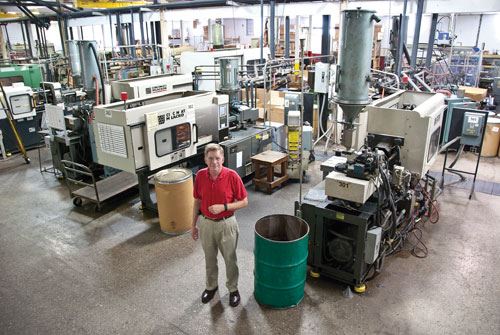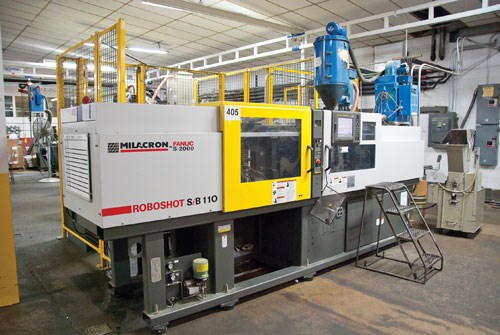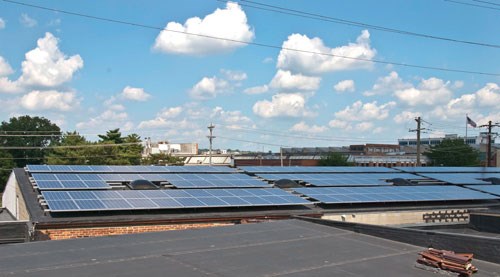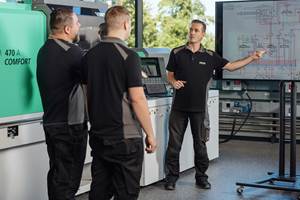On-Site: A Molder’s Makeover
Technology Upgrades Revive Recto’s Business
It was not a pretty picture: A 91-year-old custom molder teetering on the verge of shutdown. Its leaky, undersized cooling tower decrepit beyond repair. City water too expensive to consider. Outdated molding machines that were slow, imprecise, energy-hogging, and prone to breakdowns. Low capacity utilization, high reject rates, and missed delivery dates. High stress levels and “impossibly poor cash flow” that threatened the company’s viability.
That’s what faced Per Flem when he took over Recto Molded Products in 2003. Today, the Cincinnati custom molder has cash flow two to three times the level of three years ago, and the company just completed its best six months in the last eight years. How Recto remade itself, without a large infusion of cash, is a story of resourcefulness, imagination, and engineering know-how. As new owner, president, chairman, and CEO, Flem initiated a complete overhaul of the plant’s infrastructure—from water-cooling and compressed-air systems to heating, lighting, air handling, and capital equipment. The key ingredient was bringing in up-to-date technology—new machine controls, all-electric presses, automated work cells, more efficient cooling equipment and air compressors, and even solar panels on the roof.
Energy savings are the most consistent theme behind all these improvements. Recto learned so much about energy efficiency and other affordable ways to enhance profitability and competitiveness that it launched a subsidiary to market those solutions to other molders in need. It was even recognized as a finalist for 2010 Green Company of the Year award from the Cincinnati Business Courier.
NEW TECH DOES MORE WITH LESS
Founded in 1919, Recto Molded (rectomolded.com) is today a $5-million to $6-million business molding parts for conveyors (a big industry in the Cincinnati area), as well as radar detectors, automotive aftermarket, garden supplies, and medical inventory-control devices. It molds primarily PP, ABS, nylon, acetal, and polycarbonate. “We’re a short-run operation, focused on quick delivery,” Flem says. “We’ll run a job for two hours or a day. Two or three days is a long run for us.”
Flem, a graduate of the plastics program at the Univ. of Mass., Lowell, has 42 years in plastics, starting with Haveg Industries and Ford Motor Co. in the late 1960s. In 1982, he and a partner founded a precision custom injection molding firm, Performance Plastics, right next door to Recto Molded Products. His partner was the owner of Recto, who then sold out to Flem.
When Flem took over the struggling operation in 2003, it had 45 presses, 35 of them over 10 years old, and several more than three times that age. Capacity utilization was 25% to 40%. Expenses for repairs and spare parts were huge, Flem recalls. Reject rates were 25% or worse.
One of the first things he did was junk all but 11 of those older presses and purchased used but newer ones, mostly of 1995 to 2002 vintage. Six of them were the plant’s first all-electric machines, four of them Fanuc Roboshot models from Milacron, Inc. (milacron.com). Some of the used hydraulic machines were upgraded with new screws, barrels, pumps, and controls.
Recto now has 25 presses from 44 to 440 tons. With fewer but newer presses, Recto gets something like 25% to 30% more good parts out the door every day than before. Flem estimates average reject rates of 1% or less on the newer hydraulic machines and down to 0.1% for the Roboshots. Late parts deliveries are no longer a problem. Molding cycles on tight-tolerance parts are at least 10% to 20% faster with the newer hydraulics and 20% to 30% faster with all-electrics. “We love our Roboshots,” Flem enthuses.
“We got rid of those energy-hungry old machines,” he adds. He notes that an old 150-tonner, for example, drew 140 amps while a newer model pulls 95 amps. “Our old equipment was in such poor condition that were using three barrels of hydraulic oil a month due to leaks. We now use less than three barrels in a year.” Recto used to buy pallet loads of oil-absorbent clean-up material, which is no longer necessary.
ATTACKING ENERGY WASTE
Recto found that two of the biggest sources of energy waste were in plant services—cooling water and compressed air. Recto replaced a leaky 50-ton cooling tower with a 160-ton tower and a single high-capacity heat exchanger. Whereas the previous tower was undersized, the new one is oversized, but it allowed Recto to remove 160 tons of air-cooled chillers and replace them with a single 20-ton water-cooled chiller that often runs at just 5 to 10 tons of capacity. The larger tower makes use of “free” ambient cooling during the cooler months and consumes far less energy than the chillers it replaced. The tower was taken down off the roof and placed on the ground, where it is much more easily serviced.
Because the larger tower uses more water, which is expensive, Recto collects rainwater from gutters in a 2500-gal holding tank. Besides saving water cost, the rainwater contains no minerals, reducing scale buildup and need for water-treatment chemicals. It also evaporates faster than “harder” city water, so it makes the tower more efficient.
As for the air compressor, Flem found that “we were leaking half our air,” not an uncommon case, according to experts in the field. Flem hunted down the leaks by coming in on weekends when the plant was inactive and quiet to listen for the telltale hiss of air (and money) escaping. Old, noisy compressors were scrapped and replaced with smaller, quieter, and more efficient variable-speed models that can adjust to the load requirements. They are so quiet that they are placed inside the building in locations that can benefit from their heat in winter. (Heat is exhausted outside in summer.)
Flem also overhauled heating and lighting. The building was insulated and sealed with new windows. Air handling in the plant was revised in a number of ways to capture the warm air near the ceiling, heated by the machines, and direct it to the working areas at floor level in winter, and also to exhaust the heat in summer to make the plant more comfortable. Heat pumps cool several work areas by extracting heat to warm the tower water in the cooling circuits for the machines’ hydraulics, which run at 90 F.
Old mercury and metal halide lights were replaced, as were obsolete T-12 fluorescents, with more efficient T-8 and T-5 fluorescent lighting. Flem says converting a T-12 to a T-8 costs less than $20 and it can save that amount of electric cost each year of its life.
ADDING AUTOMATION
To compete with molders not just down the block but as far off as China, Recto is relying more and more on automation. It has parts-removal robots and sprue pickers (with home-made end-of-arm tooling) and uses automated work cells with three small six-axis robots and some home-built parts feeders, degaters, and assembly equipment.
Automation helped eliminate one to two persons per shift, or three to six a day. Recto has reduced its employee count from 120 to 55 through attrition and paid furloughs. Recto also tightened up its process flow to eliminate work-in-process inventory. “That way we can spot production problems quickly and fix them,” says Flem.
Looking back over all these improvements, he says, “Most of our projects were done with little or no money. Except for the cooling tower and molding presses, it was all self-funded out of cash flow.
“We still have a way to go,” he adds. Some older presses have to go, and the firm will retrofit variable-speed hydraulic-pump drives to see how much energy they save versus all-electrics. Recto will even test a-c inverter drives against more costly servo pump drives to compare cost-efficiency.
All these improvements cut the company’s electric bills from $20,000 a month to $13,000 a month, and natural gas for plant heating dropped from $20,000 annually to less than $3000 now. What’s more, Recto bought a 44-kW solar-panel array for its roof, which generates $4400 worth of energy per year plus $17,000 worth of annual renewable energy credits from Dayton Power & Light.
Flem still scrutinizes his monthly energy bills from Duke Power to tighten up energy use further. He also has come in on weekends during plant shutdowns with a portable energy meter and probe to find out where the background or “ghost” energy goes. Vending machines for cold drinks are surprising energy hogs, he asserts. “They’re not well insulated. So we turn them off on weekends.” Hot-water heaters are also shut off on weekends.
HELPING OTHERS MANAGE ENERGY
Last year, Recto founded a subsidiary, Cincinnati Process Technologies, or CPT (cinprotech.com), to leverage the experience it gained through its self-renewal and to offer it to other molders who have trimmed maintenance and other staff during the recession. CPT sales is headed by Dane Bales, who has more than 30 years’ experience selling injection molding machines for Milacron (Recto was one of his accounts).
CPT offers energy audits, maintenance services, machine upgrades, and a variety of replacement and retrofit parts, such as variable-speed drives, modern controls, and energy-efficient lighting. It also has developed its first product for sale to other molders. This Energy Management Device (EMD) offers energy savings by controlling machines’ energy consumption during startup, shutdown, and idle periods. For example, if it senses a machine is idle for a certain period, it will automatically shut down motors and bank the barrel heaters. It can also be programmed with heater shutdown sequences and soft-start startup sequences at preset times.
A second new device, being tested in Recto’s plant, is called the Energy Spy. It’s a simple box with color-coded lights (red, green, yellow) for power factor and total energy usage. It helps molders monitor electrical consumption in real time, to prevent unnecessary spikes in usage that can ratchet up the demand rate on their energy bills. If operators see the total usage light go from green to yellow, it means they are approaching their previous demand limit. To avoid exceeding that, they might, for example, delay starting up another press until one completes a job that is almost done.
Related Content
A Cost Saving Modular Approach to Resin Drying Automation
Whether implementing a moisture-sensing closed-loop system for a single dryer, or automating an entire plant, technology is available to take the guesswork and worry out of resin drying. Using a modular approach allows processors to start simple and build more capabilities over time.
Read MoreFive Ways to Increase Productivity for Injection Molders
Faster setups, automation tools and proper training and support can go a long way.
Read More50 Years of Headlines … Almost
I was lucky to get an early look at many of the past half-century’s exciting developments in plastics. Here’s a selection.
Read MoreEnsuring Repeatability: The Key to Effective Injection Molding Automation
One of automation’s key promises is repeatability: the same movement to the same location, time and time again. But to achieve that, all elements involved — robot, machine, EOAT, mold — must be in and stay in alignment.
Read MoreRead Next
People 4.0 – How to Get Buy-In from Your Staff for Industry 4.0 Systems
Implementing a production monitoring system as the foundation of a ‘smart factory’ is about integrating people with new technology as much as it is about integrating machines and computers. Here are tips from a company that has gone through the process.
Read MoreMaking the Circular Economy a Reality
Driven by brand owner demands and new worldwide legislation, the entire supply chain is working toward the shift to circularity, with some evidence the circular economy has already begun.
Read MoreRecycling Partners Collaborate to Eliminate Production Scrap Waste at NPE2024
A collaboration between show organizer PLASTICS, recycler CPR and size reduction experts WEIMA and Conair will seek to recover and recycle 100% of the parts produced at the show.
Read More






















 (2).jpg;maxWidth=300;quality=90)











